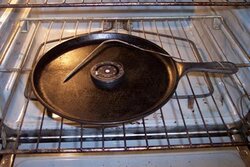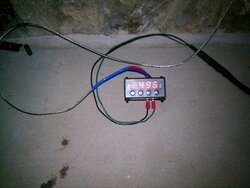Okay, I've read many posts about thermometers, for both stove top and for flue. As with many others I'm concerned that my thermometers aren't reading true. Here are some facts before I continue...
1. All the thermometers are bimetal.
2. The bimetal spring itself is not in contact with the heated surface.
3. The temperature being measured is at the point of contact.
4. There is transfer by conduction via contact, both metal and air, although not necessarily by the same amounts.
5. There is transfer by radiation through the air.
This post isn't concerned with probe thermometers, only surface mounted.
I suspect my thermometers aren't reading accurately. I've one made by Condar and two labeled Meeco Red Devil. The Condar is supposed to be for flue temps, and according to the company rep I spoke to, is not for stove top because high stove top temps may cause the thermometer decoration (letters, scale, etc.) to degrade/peel. The Meeco's I've used on both stove top and flue.
My oven, I believe, is accurate at 350F. I've acquired a well reputed oven thermometer (uses an alcohol filled glass tube), not once, but twice (nylon pad removed the scale on the first), and both say my oven is good at 350F. This may not be lab accurate, but for the purposes at hand I think it's good enough.
I put my thermometers in the oven, along with my oven thermometer, and set it at 350F. Once it reached 350F I let them sit there for 30 minutes, then checked the results.
Stove: 350F
Oven thermometer: 350F
Condar: 410F
Meeco: 480F-490F (both read the same)
Here is my question? Is the oven a reliable method of checking the reading of the thermometers? I believe it is.
Wood stove dealers and manufacturing reps have told me "Oh no, you can't do that.", and I wonder why not? They say the thermometers measure surface temperature, not air temperature. Well, that may be true in use on a stove top or flue with ambient air flowing around everything, but in an oven that is at temperature, temperature is temperature. If the inside of the oven is at 350F, then everything is; air, metal, porcelain, etc., including the thermometers. Therefore, to my thinking, the thermometers should all read the same, in this case, 350F.
I too know that oven temps from the factory can differ by a significant amount. I bake, I cook, I like an oven that is what it says it is. Mine is calibrated very closely to 350F, close enough that I can rely on it for fairly fussy baking. I also know that positioning in the oven can make a difference, so in this case I put everything in the center, gathered all together so that the difference in degrees due to location was minimized.
Some have told me that thermometers are calibrated to measure a temperature other than what the actual contact temperature is, but if that is true, how can it be reliable. The differences are as many as there are stoves on the market, no longer on the market, made by DIY's, etc., not to mention all the different locations it is possible to put a thermometer. In other words, unless you are using a probe, which is not under discussion in my post here, you can't trust a surface thermometer as an indicator of interior temperature unless it is calibrated at manufacture for a specific location on a specific model of stove, unless you have measured it yourself, or unless through experience in operating your stove. With that in mind it seems to me that a surface thermometer needs to report the temperature of the surface at the spot it is mounted, nothing more. If that is true, then testing in an oven should be fairly reliable.
Comments please...



